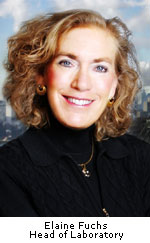Given that the ubiquity of sweat glands over the surface of the body is such a defining aspect of human physiology (and evolution), it's a wonder how little basic research has been done to understand how they work at the cellular level. Until Rockefeller University cell biologists published their recent findings in Cell, we didn't even know if sweat glands had unique stem cells. It turns out they do. The study also demonstrated that, while sweat glands are close cousins to mammary glands, adult stem cell activity is markedly different in the two systems (though they have a common progenitor), and in fact that there are four separate stem cell types that regulate maintenance and repair of glands and their epidermal-level counterparts throughout our lives.
Scientists in the Rockefeller Laboratory of Mammalian Cell Biology and Development of Dr. Elaine Fuchs, including lead study author and postdoc Catherine P. Lu, used sweat glands from the paw pads of mice in their ground-breaking stem cell research work. (Yes, those are very tiny glands to isolate!) According to a Rockefeller press release, in utero master stem cell action begins at the epidermis and works downward:
Fuchs’ team determined that just before birth, the nascent sweat duct forms as a downgrowth from progenitor cells in the epidermis, the same master cells that at different body sites give rise to mammary glands, hair follicles and many other epithelial appendages. As each duct grows deeper into the skin, a sweat gland emerges from its base.
When the researchers isolated adult stem cells from these differentiated areas, they found that the cells were still able to adapt somewhat, while retaining aspects of their specialized function. For example, adult sweat gland stem cells inserted into the mammary fat area on the test mice developed into sweat glands, but when the mouse was put through pregnancy, those same glands were able to produce milk. Fuchs summarizes:
 “Taken together, these findings tell us that adult glandular stem cells have certain intrinsic features that enable them to remember who they are in some environments, but adopt new identities in other environments.”
“Taken together, these findings tell us that adult glandular stem cells have certain intrinsic features that enable them to remember who they are in some environments, but adopt new identities in other environments.”
It's not uncommon in regenerative biology research to look at the ways that adult animal bodies routinely repair themselves and to ask how that process of rejuvenation is related to the function of stem cells. (See a related blog of ours: Stem Cell Research Meets Regenerative Biology in USC Hair-and-Feather Labs) Dr. Fuchs' research bio begins with the statement: Skin is one of the body’s major reservoirs of stem cells, as the epidermis must constantly self-renew to repair damage caused by mechanical stress and injuries. Now, that research is progressing subdermally to better understand the glandular systems that originate from common progenitor cells and the ways that they self-regulate normally, in the case of injury, or when under attack from diseases like cancer.
[Photo courtesy of Rockefeller University]
Our human skin is unique in the animal kingdom. By giving up the large amounts of protective hair and fur that other animals have, we acquired an increased vulnerability but also the ability to thermoregulate with extraordinary flexibility. Arguably this is how early hunters were able to track and kill game that was faster, stronger, tougher, and more dangerously equipped than we were with our simple weapons. So next time you're sweating, think of it as evidence of an evolutionary blessing rather than a nuisance. And keep an eye out for new research on that fortunate and complex glandular system coming out of Rockefeller labs and those of their collaborators.
This research study by the Fuchs Lab was funded by NIH as well as the NYC Tri-Institutional Stem Cell Initiative consortium, which Rockefeller participates in along with Weill Cornell and Memorial Sloan-Kettering, thanks to major funding from the Starr Foundation. Dr. Fuchs was also a co-winner of the 2012 March of Dimes Prize in Developmental Biology, as we reported in an earlier Rockefeller blog this year.
Biotechnology Calendar, Inc. welcomes New York City laboratory research scientists on the Upper East Side to its twice-annual BioResearch Product Faire event at the Rockefeller University Campus. This event, as well as the three others we hold in New York over a four day period in the fall, bring together life scientists with laboratory equipment and supply professionals to discuss the latest developments in lab technology. Make sure these events are on your calendar:
- 10/15/2012 -- Columbia University BioResearch Product Faire™
- 10/16/2012 -- Mt Sinai School of Medicine BioResearch Product Faire™
- 10/17/2012 -- Rockefeller University BioResearch Product Faire™
- 10/18/2012 -- StonyBrook University BioRearch Product Faire ™


